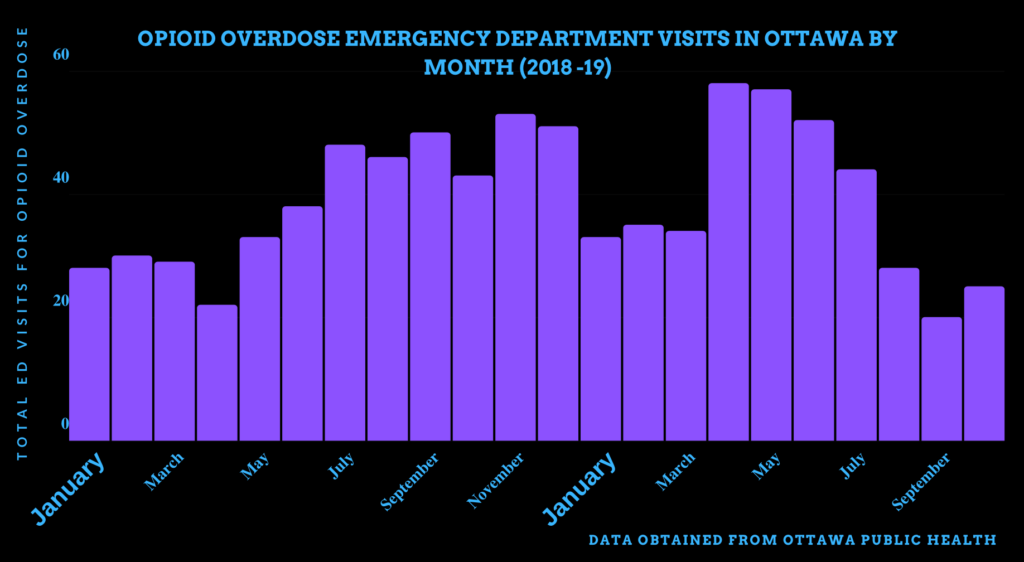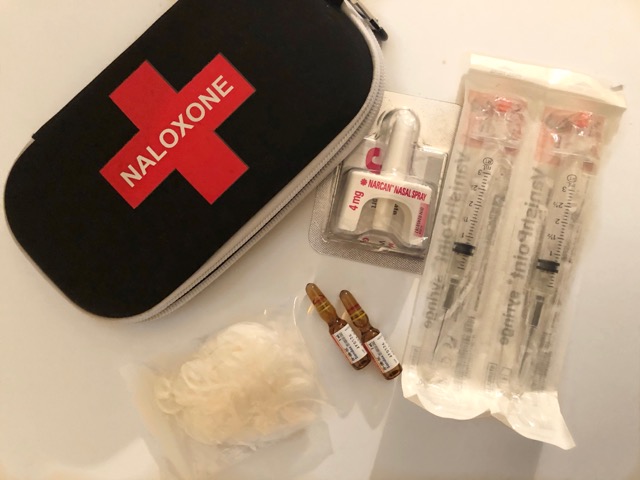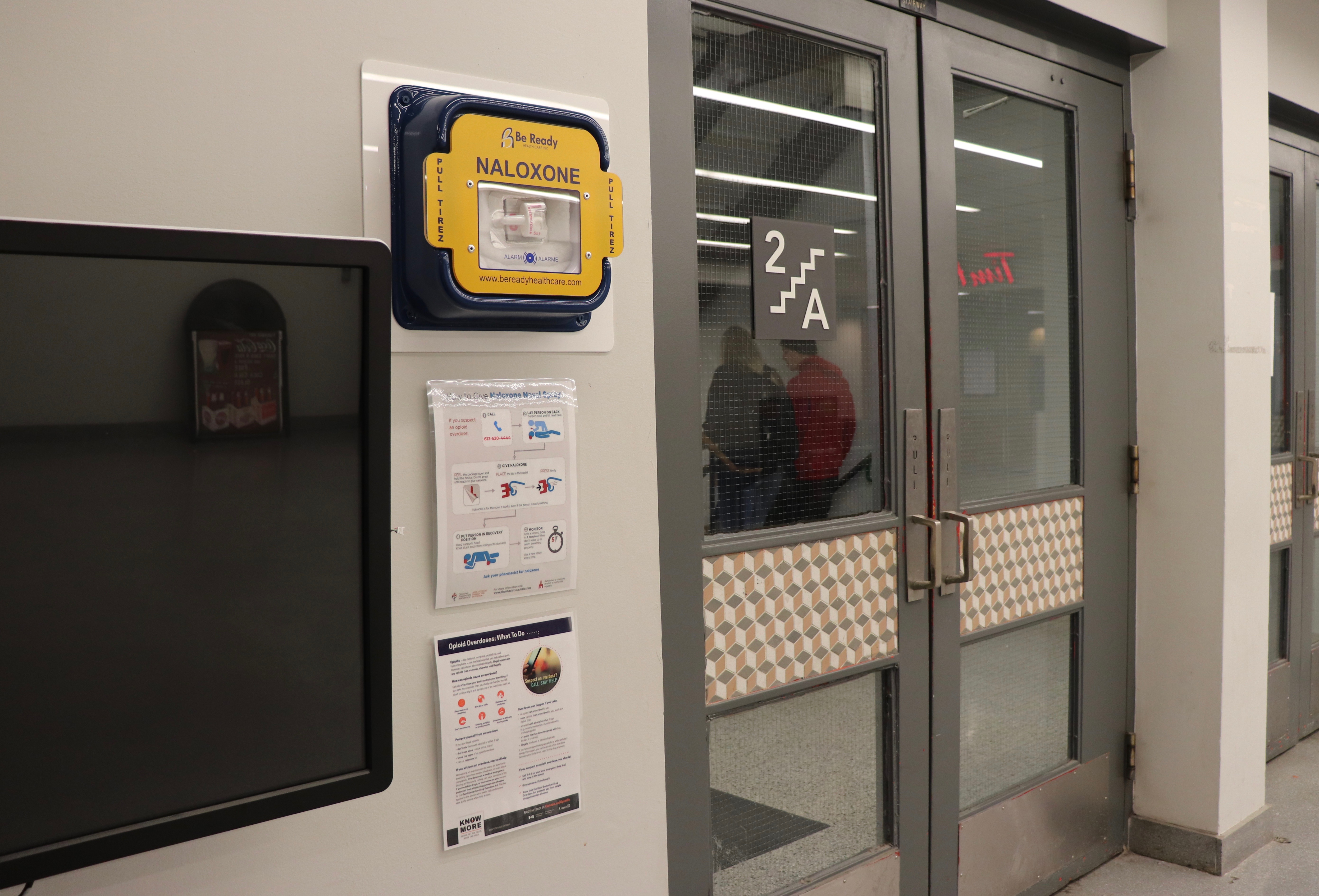Carleton has installed the university’s first-ever naloxone kit on campus, amid criticism and logistical uncertainty.
Mounted on the wall beside Abstentions in the Residence Commons building on Nov. 14, the kit marks the beginning of a campus-wide plan to increase harm reduction strategies on campus.
Naloxone is a drug which can be used as a form of antidote against the effects of an opioid overdose. It’s commonly administered through the affected person’s nose in the form of a nasal spray, often enclosed in a kit with step-by-step instructions. Despite being helpful when administered quickly, naloxone is not 100 per cent effective at reversing overdose effects.
According to Carleton officials, the new kit is available for anyone to use and is alarmed so that when opened, Campus Safety is alerted. Campus Safety can then arrive at the scene to administer more naloxone doses if necessary. As per safety protocols, Emergency Medical Services will also be contacted upon the naloxone kit’s use.

The installment was announced over Housing and Residence Life Services’ social media as well as on the Rideau River Residence Association (RRRA) president’s social media account. However, there is currently no press release from the university about the new naloxone kit.
In an emailed statement, Storey said the idea to implement the kit came from discussions with Carleton’s neuroscience department, who had noticed other Canadian campuses, such as the University of British Columbia, were placing naloxone kits in residences.
Dr. Kim Hellemans, chair of the department of neuroscience at Carleton who played a large role in the kit’s implementation, said having a naloxone kit in residence shows the university’s commitment to destigmatizing drug use.
“Stigma is still very much present, … And a lot of that is around lack of education, lack of understanding as to what is the root cause of addiction, a lot of moral finger-pointing like, ‘People who use drugs are bad, therefore we should not help them.’” — Dr. Kim Hellemans, chair of Carleton neuroscience department
“I thought that was pretty incredible that Carleton is being forward-thinking in that way, to think about harm reduction methods to keep students and staff safe,” she said.
Although Dr. Hellemans said she is proud Carleton has a naloxone kit on campus, she also recognized areas for improvement.
“Should [naloxone] be in other spaces? I think yes, probably around Oliver’s in the University Centre where there are spaces where there might be drug use situations,” she said. “But putting them broadly on campus is probably not feasible or doesn’t make much sense.”
Despite logistic uncertainty, Campus Safety director Brian Billings said there is a loose plan in place to increase the number of naloxone kits on campus.
“There’s certainly future plans in terms of developing a campus-wide strategy, this is just within residence,” Billings said.
“I believe there’s a plan … to deploy in each of the residence buildings, and then Student Affairs is then looking at the rest of the campus and into what that deployment might look like,” he said. “I’m not certain what that process is for that, but we’re certainly at the table with them.”
Carleton stakeholders, including Housing and Residence Life Services and Campus Safety, did not offer a timeline of when more naloxone kits may be implemented.
Billings said the on-campus naloxone kit is especially important during an increasingly dangerous drug scene occurring in Ottawa.
“We’d all be naïve to say that drug use is not happening, it is, and it’s pretty scary right now, too, in terms of what things are being cut with and even what the quantities are of what you’re doing with fentanyl and carfentanil.”— Brian Billings, Campus Safety director
Although Billings said drug use is occurring, the new naloxone kit is not being implemented in response to student overdoses.
“It’s just to be proactive,” he said. “It’s certainly not reactive to any trends that we’re seeing.”
However, Dr. Hellemans said when she asked Campus Safety officials in her office whether the small naloxone kits that safety officials keep on their person have been used on campus, they said they had administered naloxone “a few times.”

“Without training, how do you know these kids, if somebody drops in front of them, are they going to tilt the head back far enough? Are they going to shove the nasal kit far enough up the nose for it to work in one shot?” asked Smith.
“And when that person’s lips go blue and they die in front of that kid, are they going to feel responsible when it wasn’t their fault that there wasn’t a second, or third, or fourth kit around?”— Charlotte Smith, master’s of sociology student
“It’s super problematic because you can follow the fucking piece of paper that’s in the kit, but you’re missing that whole humanity piece, that whole compassion piece, that comes along with the training,” Smith said of the importance of providing naloxone training for students.
Smith also opened up about saving the life of her friend who overdosed by administering naloxone.
“I don’t think I did do the nasal spray correctly, I don’t think I did tilt her head back far enough, and I don’t think I was forceful enough with it,” Smith said. “It doesn’t really emphasize that on the piece of paper [in the kit].”
Despite saying she is “really happy and appreciative that finally Carleton has installed a naloxone [kit],” Smith also said the timing is lacking.
“I think it’s sad, for the last few years we’ve been in an opioid crisis,” she said. “For those of us who use hard drugs or have, we have so many friends who are dead now because people weren’t willing to listen or put themselves in others’ shoes, or feel compassion, or believe that the lives of people who use drugs matter.”
Smith also shared worries over the quantity of harm reduction supplies at Carleton.
“Carleton finally puts one nasal spray, but … it took me two nasal sprays and an injection to save my friend,” Smith said. “Putting one kit on the wall, even if Carleton doesn’t use it, what kind of message does that send about naloxone and harm reduction? ‘Oh this is enough to save a life,’ like a defibrillator on a wall?”
“If I would’ve only had one nasal kit that day, which was like literally two months ago, [my friend] would be dead, so it just really, really worries me that Carleton is putting that there.”— Charlotte Smith, master’s of sociology student
“Why the hell not just load up a cabinet, right, and since there is this lack of safe space to talk about drug use on campus, why not have just a cupboard where people can access naloxone kits,” she said.
Although students can access naloxone at off-campus drug stores to be carried on their person, Smith said they shouldn’t have to.
“[Students] can go to pharmacies sure, but why can’t Carleton do more? Why should they have to go to the pharmacy? Everyone should have access to a kit for themselves,” Smith added.

“I don’t hear people talking about harm reduction on campus, it’s wonderful that they’ve put up a nasal spray, but how many people know how to use it?” Smith asked.
Speaking to students about drugs is hard but it could save lives, she added.
“Trying to keep [drug use] quiet and making it seem as if it doesn’t exist, that is harmful because I mean where do you go for help,” Smith said.
“Find ways to make this a normal part of our discourse, to normalize harm reduction in the same way that negative stereotypes have been normalized.”
— Charlotte Smith, master’s of sociology student
As one of the Carleton stakeholders who promoted the naloxone kit on his social media, RRRA president Douglas Cochrane agreed that more should be done to let students know of the naloxone kit on campus.
“There’s definitely more that needs to be done in terms of students knowing that those things are readily available to them,” he said. “I would love to table and have tabling events whether it be with Housing and Residence Life or Campus Safety.”
Although Cochrane said tabling would be effective, he added RRRA currently does not have the time between ongoing projects to plan tabling events.
Cochrane, who also said he originally pitched the naloxone kit idea to university officials which then led to meetings with Storey, added having a naloxone kit is a good first step, but residence needs to be doing more.
“In an ideal world, I would like there to be one in every residence,” he said. “But in addition to that, in a perfect world, I’d like to see every res fellow have the small ones they can carry included in their kits.”
Cochrane said during his time as a residence fellow at Carleton, naloxone training was not offered, but said “it’s something that can be discussed to be implemented within the next August training session.”
Carleton University Students’ Association (CUSA) president Lily Akagbosu, who works regularly with the university administration and RRRA, said she did not know the naloxone kit was implemented at Carleton, despite attending previous naloxone training workshops at the university.
“There’s always a difference of opinions in how to promote certain things that may be conceived as controversial,” Akagbosu said.
“I definitely think there’s no point in doing something if people don’t know about it, so there is room for more promotional opportunity. At the same time, I don’t necessarily think it should take up too much space where we’re promoting it at the expense of other things.” — Lily Akagbosu, CUSA president
When told Carleton is planning on implementing more kits in the future, Smith said the time is now.
“Get the kits out, I just did a naloxone training session … we handed out 30 naloxone kits,” she said.
“I don’t know why we need a big two years of discussion while people are dying,” she added.
“I think Carleton as a campus should be a little bit braver, and a little bit bolder, in leading the way to a more open and compassionate society.”
Featured image by Temur Durrani.






